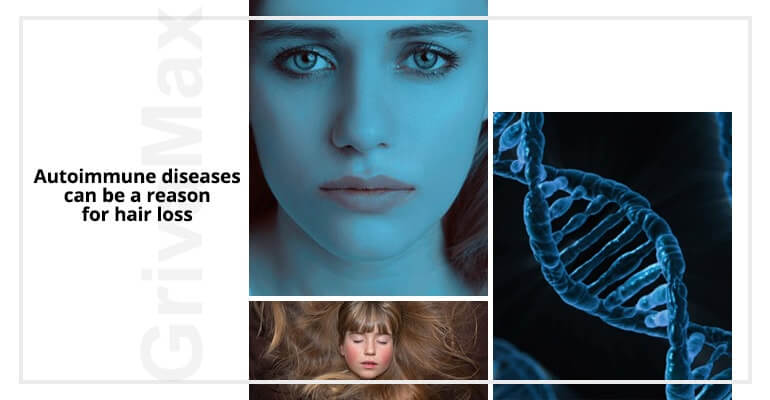When speaking about hair loss, we should understand the difference between normal shedding (50-100 hairs per day), and a condition when you have to see the trichologist. Is it necessary? Yes, because only a doctor can help you to find out the exact cause of severe hair loss and to choose the right treatment method. So if you notice strands of hair on your brush, it’s time to take action. Here we are going to describe the reasons for abnormal hair loss and how to deal with this problem.
All factors can be divided into two groups – external and internal. External factors are extreme care, imbalanced diet, and stresses. The internal causes are telogen phase of hair cycle, genetics, thyroid disorders, lupus, iron-deficiency anemia, polycystic ovaries syndrome, scalp disease, and alopecia.
Excessive care
Hair loses its natural and healthy state when it’s over treated with aggressive cosmetic products – shampoos, hair dyes, tonics, gels, mousses, and sprays combined with hair dryers and tap water.
Symptoms. Hair gets dull, «shaggy» with split ends. Hair doesn’t even fall, but breaks. You don’t see the hair follicles at the ends, which is typical for the telogen phase of hair cycle.
Diagnosis. Doctor will inspect your hair, probably pulling out several to make sure it falls without follicles.
Solutions. The answer is obvious: reduce the intensity of hair care and switch to less aggressive cosmetic products and care methods. Avoid or reduce the use of different hair styling gadgets, don’t use hot air for drying, chose hair dyes which are closer to your natural color and don’t require bleaching. Don’t brush your hair if it already has a hardened hair styling product on.

Iron deficiency anemia
Adult woman should receive 18 mg of iron daily (8 mg after menopause). Sometimes woman doesn’t get the necessary amount. Iron is in charge of erythrocytes – elements which transport oxygen to the tissues and cells. No oxygen = no energy.
Symptoms. Severe fatigue, exhaustion, weakness, short of breath, pale skin color. Possible headaches, problems with concentrating, cold hands and feet, and hair loss.
Diagnosis. The best way to detect anemia caused by iron insufficiency (there are different types of anemia) is by taking a blood test, which will show hemoglobin and erythrocytes levels.
Solutions. The most important thing is to correct your diet and take iron containing supplements. There are also special supplements designed for hair treatment. Besides iron, they include other necessary healthy hair components.
Scalp diseases
Scalp conditions are related to the health of the hair. The most common problem is dandruff (seborrhea dermatitis). Other reasons for hair loss are fungal infections, ringworm, and psoriasis.
Symptoms. «Snow» on the head can be caused by fungal infections, hormonal disorders, or excessive sebum production. All other diseases can appear in the form of unusual rashes, ulcers, crusts, inflammations, and bald spots.
Diagnosis. Dermatologist will inspect the scalp visually, with a possible further biopsy of the damaged areas to detect the type of the fungal infection.
Solutions. Immediately see a dermatologist or trichologist, and proceed only under the doctor’s supervision. Only buy shampoo which has been prescribed by a doctor, and don’t trust the commercials. Oral contraceptives, ointments and other products must also be recommended by a doctor. More information about oral contraceptives and hair loss you can find here: https://www.grivamax.com/oral-contraceptives-hair-loss/.

Alopecia
Alopecia is a mysterious autoimmune disorder that is quite common, and affects both genders. The reason is still unknown – it can be stress or an illness.
Symptoms. Hair loss can happen on the head (some areas or all around the surface) or on the body. Some patients complained about some sort of discomfort (irritation, tingling) that turns into bald spots later.
Diagnosis. Doctor will inspect your head and take a blood test, to exclude other factors of hair loss.
Solutions. Alopecia can be treated with different medications, including corticosteroids, Minoxidil. A healthy and stress-free lifestyle plays an important role in the patient’s well-being.
Telogen effluvium
Is the resting phase of hair, when it’s falling out and being replaced by new hair. But under certain circumstances, the number of hair during telogen mode is increasing, which causes more severe hair loss.
Factors that cause this process:
- hormonal disorders, for example, postpartum;
- severe stress;
- serious surgery;
- abrupt weight loss;
- certain drugs (NSAIDs, antidepressants, beta-blockers).
Symptoms. Severe hair loss: strands on the comb or on the pillow, or a frequently clogged drain. After serious stress, this condition can last for 1.5 – 3 months.
Diagnosis. There are no special methods. A doctor can ask you about your recent life events, lifestyle, and medication use. He can also examine a hair follicle to see if the hair went through the full growth cycle.
Solutions. If hair loss is related to a recent surgery or postpartum, then you just have to wait. If it was caused by using medications, then you have to consult a doctor about changing the treatment schedule (reduce a dosage switch to another drug). If the reason was stress, then you need to calm down. In this case, aromatherapy or yoga lessons may help. Laser cap for hair growth is another effective method of treatment.

Genetics
Inherited, or androgenic alopecia, is the most common reason for hair loss. Genes can be inherited from your mother’s or father’s side. It’s more likely that both parents were gene carriers.
Symptoms. Hair loss happens slowly, and the first signs appear at a young age, even at 20 years old. Inherited alopecia in women can be developed in certain spots (often behind the hair bangs) or have a diffusive form. Hair thins, which can lead to the appearance of bald spots if you ignore the symptoms.
Diagnosis. A dermatologist will analyze the history of hair loss and might take a blood test to eliminate hereditary factors. Sometimes a biopsy might be needed to study follicles: of hair loss was genetically caused, follicles will be smaller than normal.
Solutions. The process should be slowed down as soon as possible. Minoxidil can be prescribed for women, but in a smaller dosage than for men, and not during pregnancy or while breast feeding. Men are prescribed Finasteride and some other medications.
Thyroid diseases
Hypothyroidism is a problem for millions of people. Thyroid produces hormones that are in charge of heart rate, metabolism, mood, etc. Insufficient amounts of hormones will cause hypothyroidism, while excessive numbers of hormones is the cause of hyperthyroidism. The first one is more common than the second – about five times more.
Symptoms. Some of the hypothyroid symptoms are abrupt weight gain, constant fatigue, depression, constipation, and problems with concentration. Hair, skin and nails become fragile and vulnerable, and hair falls out. Women, especially after 50 years old, are more likely to become victims of this disorder.
Hyperthyroidism can be identified with unreasonable weight loss, frequent heart rate, nervousness, irritation, diarrhea, wet skin, muscles weakness, bulging eyes and possible hair loss, which is caused by an accelerated metabolism.
Diagnosis. Blood test to detect thyrotropic hormone (TRH), which is produced by hypophysis to stimulate the work of the thyroid. With hypothyroidism, its level is elevated – with hyperthyroidism, it will be lower than normal.
Solutions. A doctor will prescribe thyroid regulating medications. Also, you have to constantly detect the level is TRH in your blood, in order to control the treatment process and change dosages.

Lupus
Lupus is a chronic autoimmune disease (with this type of condition, the body attacks itself). It’s quite a rare disease, which more likely affects women of reproductive age.
Symptoms. Lupus can be characterized by extreme fatigue, headaches, ulcers in the mouth, tenderness, swelling of the joints, rash on the edge of the nose in the shape of butterflies, sensitivity to the sun, possible fever, swelling of the hands and eyes, bags under the eyes, pain in the chest, and anemia. Hair loss can be moderate, after washing and combing, or severe, with appearance of bald spots and rashes on the head.
Diagnosis. Lupus is hard to be identified, because its symptoms are common with many other diseases. A rheumatologist needs to examine the joints and tissues for signs of inflammation and check the patient’s conditions with a list of diagnosis criteria. Lupus can be detected by the level of antinuclear antibodies (ANA) in the blood.
Solutions. A rheumatologist might prescribe generic medications. An ointment for local use might be also recommended if hair loss is accompanied by a rash on the head.
Polycystic ovary syndrome
This disease is quite common and has a hormonal origin, and it can begin at quite an early age. Ovaries produce too many male hormones, and as a result develop gynecological disorders, even infertility.
Symptoms. Problems with periods (irregular or amenorrhea), facial hair growth accompanied by hair loss on the head, and acne. Doctors can spot multiple cysts on the ovaries.
Diagnosis. Blood test to detect male hormones, and an ultrasound of inner genital organs.
Solutions. PCOS requires long-term treatment based on complex methods. Basically, different medications should correct the hormonal background. There are certain oral contraceptives, which also reduce the level of male hormones. You might have to lose weight. When dealing with PCOS in cases of infertility, it requires a different treatment, but that’s another story.
As you see, hair loss is not only a problem for your look, but also an important indicator of many serious health conditions. In case of severe hair changes or loss, you should consult a doctor immediately.
Specialists will help you to choose the main treatment methods and therapy, combined with alternative methods. For example, low-level laser therapy will slow down the process of hair loss, and at the same time speed up the hair restoration on damaged areas. It will also improve the condition of skin diseases.
 989
989














